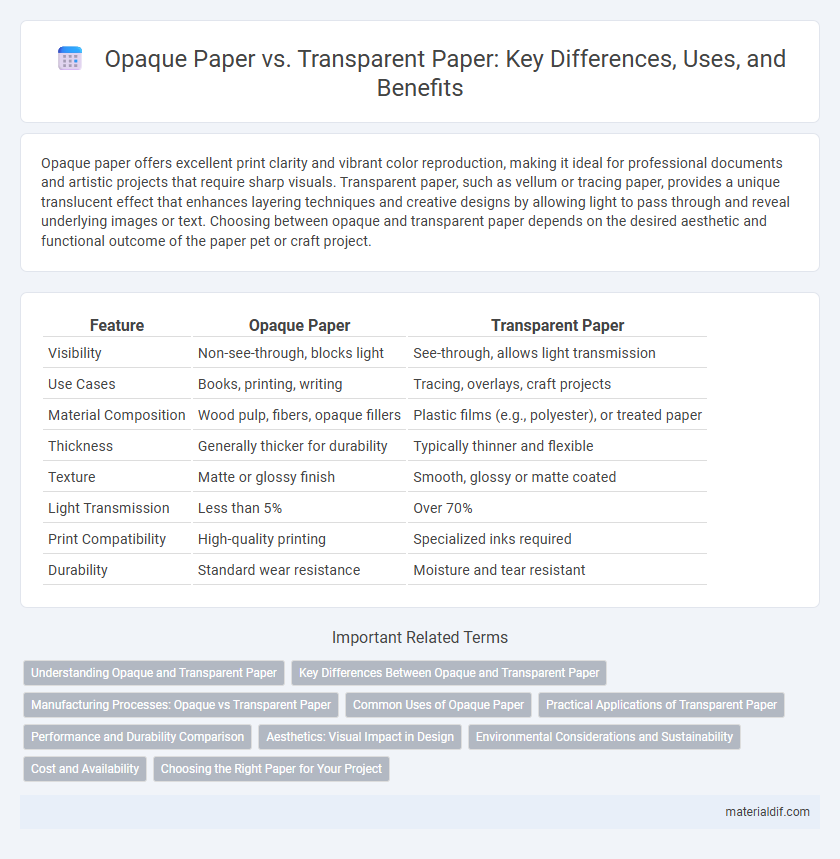Opaque paper offers excellent print clarity and vibrant color reproduction, making it ideal for professional documents and artistic projects that require sharp visuals. Transparent paper, such as vellum or tracing paper, provides a unique translucent effect that enhances layering techniques and creative designs by allowing light to pass through and reveal underlying images or text. Choosing between opaque and transparent paper depends on the desired aesthetic and functional outcome of the paper pet or craft project.
Table of Comparison
| Feature | Opaque Paper | Transparent Paper |
|---|---|---|
| Visibility | Non-see-through, blocks light | See-through, allows light transmission |
| Use Cases | Books, printing, writing | Tracing, overlays, craft projects |
| Material Composition | Wood pulp, fibers, opaque fillers | Plastic films (e.g., polyester), or treated paper |
| Thickness | Generally thicker for durability | Typically thinner and flexible |
| Texture | Matte or glossy finish | Smooth, glossy or matte coated |
| Light Transmission | Less than 5% | Over 70% |
| Print Compatibility | High-quality printing | Specialized inks required |
| Durability | Standard wear resistance | Moisture and tear resistant |
Understanding Opaque and Transparent Paper
Opaque paper prevents light from passing through, making it ideal for printing and writing where clarity and legibility are crucial. Transparent paper, such as tracing paper or vellum, allows light transmission, enabling artists and designers to overlay images for tracing or design revisions. Understanding the properties of opaque versus transparent paper helps select the appropriate material based on the desired visibility and application needs.
Key Differences Between Opaque and Transparent Paper
Opaque paper blocks light transmission, making printed content more vibrant and preventing show-through, ideal for double-sided printing and professional documents. Transparent paper, such as vellum or tracing paper, allows light to pass through, enabling overlay designs and artistic layering for creative projects. The choice between opaque and transparent paper depends on printing needs, visual effects desired, and project functionality.
Manufacturing Processes: Opaque vs Transparent Paper
Opaque paper manufacturing involves the inclusion of fillers such as calcium carbonate or kaolin, which scatter light and enhance opacity by blocking light transmission through the sheet. Transparent paper production requires minimal additives and uses highly refined cellulose fibers arranged in a manner that allows light to pass through, often employing rigorous beating and pressing techniques to reduce voids. The distinct processing parameters directly influence the paper's light interaction properties, with opacity achieved through particle dispersion and transparency through fiber alignment and density control.
Common Uses of Opaque Paper
Opaque paper is commonly used in printing books, brochures, and office documents due to its ability to prevent text and images from showing through the opposite side, ensuring readability and a professional appearance. It is favored for packaging materials and labels where clarity and opacity are essential to display information without distraction. This paper type is also preferred in art projects and crafts that require a solid background or privacy.
Practical Applications of Transparent Paper
Transparent paper is extensively used in packaging industries to provide visibility while protecting products from external contaminants. It finds practical application in tracing and drafting due to its smooth surface and translucency, allowing designers and architects to overlay designs easily. Additionally, transparent paper is employed in art and craft projects where light diffusion and delicate aesthetics are essential.
Performance and Durability Comparison
Opaque paper offers superior durability with high resistance to tearing and creasing, making it ideal for heavy-use printing applications. Transparent paper, often made from vellum or synthetic materials, provides excellent translucency for design and tracing but generally sacrifices strength and longevity compared to opaque variants. Performance-wise, opaque paper excels in color vibrancy and ink absorption, while transparent paper typically displays higher susceptibility to smudging and wear.
Aesthetics: Visual Impact in Design
Opaque paper enhances visual impact by providing richer color depth and sharper contrast, making designs appear more vibrant and professional. Transparent paper offers a unique aesthetic with its translucency, allowing layered designs and subtle overlays that create depth and intrigue. Choosing between opaque and transparent paper depends on the desired visual effect, where opacity ensures boldness and transparency introduces ethereal elegance.
Environmental Considerations and Sustainability
Opaque paper, typically made from virgin fibers and containing chemical additives, often requires more energy and water during production, leading to a higher environmental footprint compared to transparent paper. Transparent paper, such as glassine or cellulose-based variants, is usually biodegradable and recyclable, offering improved sustainability through reduced waste and lower resource consumption. Choosing transparent paper supports eco-friendly practices by enhancing recyclability and minimizing the impact of deforestation and chemical pollution associated with opaque paper manufacturing.
Cost and Availability
Opaque paper is generally more cost-effective and widely available, making it the preferred choice for everyday printing, packaging, and office use. Transparent paper, such as tracing or vellum paper, tends to be more expensive due to specialized manufacturing processes and limited demand, resulting in lower availability in general retail markets. Businesses often opt for opaque paper to minimize costs while ensuring easy procurement from multiple suppliers.
Choosing the Right Paper for Your Project
Opaque paper offers excellent light-blocking properties and superior print clarity, making it ideal for professional documents, brochures, and art prints where text and images need to stand out. Transparent paper, such as vellum or tracing paper, provides a unique translucent effect perfect for creative overlays, design tracing, and invitations that require a delicate, ethereal quality. Selecting the right paper depends on the project's purpose, desired visual impact, and printing method to ensure both functionality and aesthetic appeal.
Opaque Paper vs Transparent Paper Infographic

 materialdif.com
materialdif.com